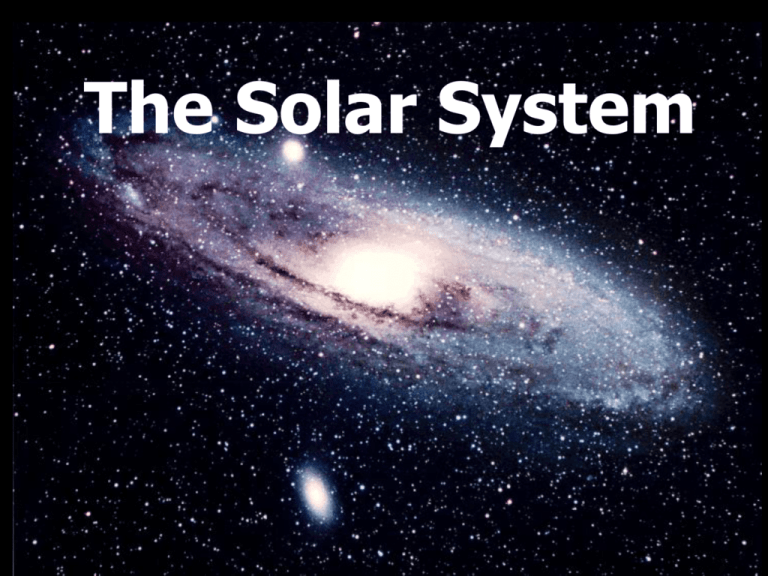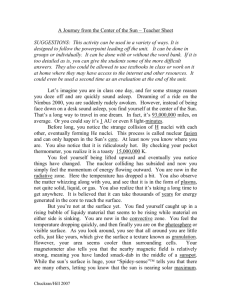Sun notes
advertisement

The Solar System Nebula Theory (our solar system) • The solar system started from the spinning and condensing of a cloud of dust and gas. The greatest matter formed the sun with the remaining becoming the planets. Inner Planets • Terrestrial planets – Mercury – Venus – Earth – Mars • Formed as small rocky material nearest to the protostar(our sun) cooled. Jovian (outer planets) • Jupiter • Saturn • Uranus • Neptune Planets orbit in ellipses Perihelion- when the planet is closest to the sun Aphelion- when the planets are farthest away Sun http://astro.unl.edu/classaction/animatio ns/sunsolarenergy/fusion01.html •Core –nuclear fusion occurs – In nuclear fusion, the nuclei of atoms are physically joined together to form greater mass atoms. This process of creating new elements is called nucleosynthesis. Most common is hydrogen to helium – Must occur at temperature greater than 10 million degrees C Core • In the core, mass is converted to energy by the process of nuclear fusion. • Einstein’s energy-mass equivalence equation explains this: • E = mc2 • In extreme conditions such as in the cores of stars, matter is converted to energy. • The energy in the core of the Sun is in the form of gamma ray photons. As they move outward from the core, they are absorbed and re-emitted many times, and in the process, lose transfer some of their energy. Sun •Radiative zone- energy moves outward in waves •Photons try to move outward from the core where they are produced, but the density is so great that they are reabsorbed and remitted many times. Each time they are freed, it is in a random direction. This process, called the random walk, causes the solar photons to be trapped inside this zone of the Sun for anywhere between 100 000 to 1 million years. •Convection zonewarmed gases rise and cool gases sink Convective Zone At the bottom of the convective zone the temperature is about 2,000,000° C. This is "cool" enough for heavier ions (such as C,N,O, and Fe) to hold onto some of their electrons. This makes it harder for photons to get through, trapping pockets of heat that causes the fluid to "boil" or convect. This convection transports heat rapidly to the surface. The fluid expands and cools as it rises. At the photosphere, the temperature has dropped to 6000° C and the density is only 1/10,000th the density of Earth’s atmosphere. The tops of the convective bubbles are visible at the surface as granules. Photosphere The photosphere is the visible surface of the Sun. It is the zone where light breaks free and begins its journey through space. Features of the Photosphere Granules are the tops of convection cells. They are in constant motion, like a pot of boiling oatmeal. The white areas are rising, while the dark areas are falling. Features of the Photosphere Sunspots are dark areas that mark places where magnetic fields are breaking through the photosphere. They usually occur in groups or pairs. The dark, inner area of the sunspot is the umbra. It is about 1500°C cooler than the surrounding photosphere. The outer transition area around the sunspot is the penumbra. It has a temperature in between the umbra and the photosphere. Sunspot Cycle Every 11 years, the number of sunspots builds from a minimum to a large number of sunspots. This corresponds to a direct increase in solar activity. We are now at the peak of the sunspot cycle, a time known as Solar Max. Sunspots and magnetic fields Every 11 years, at the time of Solar Max, the magnetic poles of the Sun reverse polarities. Since each pole maintains a polarity for 11 years, the full magnetic cycle of the Sun is 22 years. CHROMOSPHERE • Above the photosphere • Reddish in color • The Chromosphere is the “lower atmosphere” of the Sun. It glows red due to the emission of red light from hydrogen. This wavelength of red light is known as “Hydrogen-alpha” radiation. • Sunspots: are temporary phenomena on the photosphere of the Sun that appear visibly as dark spots compared to surrounding regions. – They are caused by intense magnetic activity, which inhibits convection CORONA • Outermost atmosphere of the sun • Seen only during a total solar eclipse • Very hot but thin Solar Winds • Corona prevents most particles from exiting the sun. However, some Ions/ particles escape as Solar Winds. • Causes Auroras (northern lights). SOLAR FLARES- Large Eruptions of Gas Increases Auroras Prominences: large, bright, gaseous feature extending outward from the Sun's surface, often in a loop shape. A coronal mass ejection (CME): is a massive burst of solar wind and magnetic fields rising above the solar corona or being released into space. * Can only see corona during an eclipse SOLAR FLARES CORONA SUN SPOTS PROMINENCE SPICULES CONVECTION ZONE CHROMOSPHERE PHOTOSPHERE RADIATIVE ZONE CORE • An aurora is a natural light display in the sky – Auroras are caused by charged particles, mainly electrons and protons Increased solar flares activity can interrupt communication systems on earth











